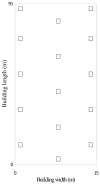Effectiveness of Biocidal Paint Containing Permethrin, Ultramarine and Violet 23 Against Alphitobius diaperinus (Panzer) (Coleoptera: Tenebrionidae) in Laboratories and Poultry Houses
- PMID: 32825334
- PMCID: PMC7552689
- DOI: 10.3390/ani10091461
Effectiveness of Biocidal Paint Containing Permethrin, Ultramarine and Violet 23 Against Alphitobius diaperinus (Panzer) (Coleoptera: Tenebrionidae) in Laboratories and Poultry Houses
Abstract
Reducing Alphitobius diaperinus in poultry production is a difficult task. However, attempts should be made to control the insect pest, as it poses a serious threat to the life and health of the chickens, as well as the workers on a farm. Our research was conducted in two stages to assess the effectiveness of the biocidal paint against A. diaperinus, containing active substances such as permethrin and a mixture of ultramarine and violet 23. In the first stage, under laboratory conditions, after 22 days, 100% mortality of A. diaperinus larvae and adults was achieved. This allowed us to assume that the biocidal paint may also be effective in poultry houses. In the poultry house where biocidal paint was applied, the number of insects decreased continuously alongside the sampling dates. In both research stages, the biocidal paint proved more effective against A. diaperinus than traditional limewash, and also the time to effective interaction of the paint was noted. Additionally, it was observed that the larvae were more susceptible to the active substances than adults. The research was practical, however, further analyses are necessary to fully control A. diaperinus, especially in poultry houses.
Keywords: broiler houses; insect pest; insecticide; lesser mealworm; limewash; poultry; repellent.
Conflict of interest statement
The authors declare no conflict of interests. The funders had no role in the design of the study; in the collection, analyses, or interpretation of data; in the writing of the manuscript, or in the decision to publish the results.
Figures


Similar articles
-
Efficacy of a Biocidal Paint in Controlling Alphitobius diaperinus (Panzer) (Coleoptera: Tenebrionidae) and Improving the Quality of Air and Litter in Poultry Houses.Animals (Basel). 2022 May 14;12(10):1264. doi: 10.3390/ani12101264. Animals (Basel). 2022. PMID: 35625110 Free PMC article.
-
Development of pull and push-pull systems for management of lesser mealworm, Alphitobius diaperinus, in poultry houses using alarm and aggregation pheromones.Pest Manag Sci. 2019 Apr;75(4):1107-1114. doi: 10.1002/ps.5225. Epub 2018 Nov 12. Pest Manag Sci. 2019. PMID: 30270497
-
Pathogenicity of an Entomopathogenic Nematode, Steinernema carpocapsae on Alphitobius diaperinus (Coleoptera: Tenebrionidae) Strains From Turkey.J Econ Entomol. 2022 Aug 10;115(4):1303-1309. doi: 10.1093/jee/toac100. J Econ Entomol. 2022. PMID: 35762678
-
Baseline responses of adult Alphitobius diaperinus (Coleoptera: Tenebrionidae) to fenitrothion and susceptibility status of populations in Queensland and New South Wales, Australia.J Econ Entomol. 2005 Jun;98(3):938-42. doi: 10.1603/0022-0493-98.3.938. J Econ Entomol. 2005. PMID: 16022325
-
A Review of Biological and Sustainable Management Approaches for Alphitobius diaperinus, a Major Pest in Poultry Facilities.Vet Sci. 2025 Feb 12;12(2):158. doi: 10.3390/vetsci12020158. Vet Sci. 2025. PMID: 40005918 Free PMC article. Review.
Cited by
-
Efficacy of a Biocidal Paint in Controlling Alphitobius diaperinus (Panzer) (Coleoptera: Tenebrionidae) and Improving the Quality of Air and Litter in Poultry Houses.Animals (Basel). 2022 May 14;12(10):1264. doi: 10.3390/ani12101264. Animals (Basel). 2022. PMID: 35625110 Free PMC article.
-
Short- and Long-Term Mortalities of Small and Large Larvae of Alphitobius diaperinus (Panzer) (Coleoptera: Tenebrionidae) on Concrete Surfaces Treated with Three Insecticides: Impact of Food.Insects. 2022 Apr 8;13(4):366. doi: 10.3390/insects13040366. Insects. 2022. PMID: 35447808 Free PMC article.
References
-
- Guatam R.D. Exploration of lesser mealworm for the control of storage insects together with its stages and effect on seed viability. Agri. Situat. India. 1989;44:487–489.
-
- Savage S. Reducing darkling beetles. Poult. Dig. 1992;51:34–36.
LinkOut - more resources
Full Text Sources

